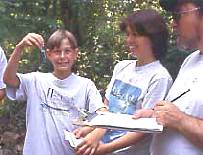

Overseeing the Water Resources of Loudoun County, VA
Just for Kids
 |
 |
Links to some great games & other resources
Water
Festival
Puzzlemaker
Water
Word Search
Kid's Stuff from
the Environmental Protection Agency
Water in
the City
Water
Word Scramble
Water
Drinker Bloopers
Seaworld's
Animal Information
What's
Wrong With this Picture?
Let's start basic: What is a watershed?
A watershed is an area of land that drains into a lake or river. As rainwater and melting snow run downhill, they carry sediment and other materials into our streams, lakes, wetlands and groundwater.
Why is
your watershed important?
We all live in a watershed. Watersheds are the places we call home, where
we work and where we play. Everyone relies on water and other natural
resources to exist. What you and others do on the land impacts the quality
and quantity of water and our other natural resources. Watersheds
have special features.
Healthy
watersheds are vital for a healthy environment and economy. Our watersheds
provide water for drinking, irrigation and industry. Many people also
enjoy lakes and streams for their beauty and for boating, fishing and
swimming. Wildlife also need healthy watersheds for food and shelter.
Managing the water and other natural resources is an effective and
efficient way to sustain the local economy and environmental health.
Scientists and leaders now recognize the best way to protect the vital natural resources is to understand and manage them on a watershed basis. Everything that is done in a watershed affects the watershed's system.
Pollutants
and water quality.
In the past, most water quality problems were traced to the most obvious
cause ... point-source pollution. This means the problem can be traced to
a specific location such as a pipe or disposal site.
Technical
and regulatory methods have been used to detect and control these
problems. Much progress has been made in preventing further water quality
problems from point sources.
However, water quality problems from nonpoint-source pollution are more
difficult to isolate and control. These sources are often hard to identify
and difficult to measure. This type of pollution results from a wide
variety of activities over a wide area.
Nonpoint-source
pollutants are in the water that runs off crop or forest land. Others
include failing septic systems, parking lots, construction sites,
irrigation systems and drainage systems. It can even result from
automobile exhaust getting in the atmosphere and falling back to earth in
the rain.
A partnership among all who live, work or play in the watershed can help
identify concerns, educate those involved and encourage them to take
action. Watershed management plans focus on prevention of pollution. This
is easier and cheaper than trying to cleanup a watershed after the fact.
Understanding your watershed is the first step in protecting the water and
other natural resources.
Understanding
your watershed.
The watershed where you live is a dynamic and unique place. It is a
complex web of natural resources - soil, water, air, plants and animals.
Yet, everyday activities can impact these resources, ultimately impacting
our well-being and economic livelihood.
The EPA has a lot more information that can help you understand watersheds.
|
Across Down |
How much water we use in a day Taking a bath or shower: 15-30 gallons Watering the lawn: 180 gallons Washing the dishes: 30 gallons Washing clothes: 15 - 60 gallons Flushing the toilet: 4 - 7 gallons Brushing teeth: 1 gallon Drinking: 1/2 gallon |
info@loudounwatershedwatch.org Copyright © 2011 Loudoun Watershed Watch